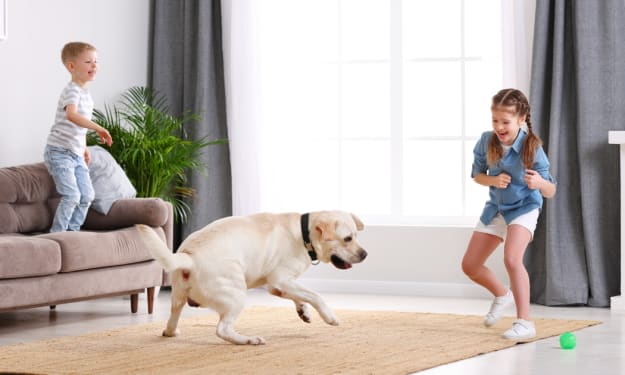How to Crate Train a Puppy
Step-by-Step Guide to Crate Training

So, you’ve brought home an adorable puppy, and now you’re wondering how to crate train them. Great choice! Crate training is a fantastic way to ensure your new furry friend feels safe and secure while also helping with housebreaking and reducing anxiety. In this article, we'll walk you through everything you need to know about crate training your puppy, from selecting the right crate to establishing a routine that works for both of you.
I learned how to crate train my puppy in a month using the Ultimate Dog Training Guide.
Crate training is a method of teaching your puppy to see their crate as a safe and comfortable space. It involves gradually getting them used to spending time in the crate, making it a positive experience. The benefits are numerous: it aids in house training, provides a safe place when you’re not around, and can even make traveling easier.
Choosing the Right Crate
When it comes to crates, you’ve got options. There are wire crates, plastic crates, and even soft-sided crates. The type you choose depends on your puppy's size and temperament, as well as your needs. Ensure the crate is large enough for your puppy to stand, turn around, and lie down comfortably but not so big that they can use one end as a bathroom
Setting Up the Crate
Location, location, location! Place the crate in an area where your family spends a lot of time, but away from drafts or direct sunlight. Make it cozy with a soft bed or blanket and a few favorite toys. The goal is to make the crate feel like a safe, inviting den.
Introducing Your Puppy to the Crate
First impressions matter. Start by letting your puppy explore the crate on their own. Keep the door open and let them go in and out as they please. Toss in a few treats or a favorite toy to create positive associations. Patience is key here; don’t rush this step.
Creating a Positive Experience
To make the crate a happy place, use treats and toys to entice your puppy inside. Gradually increase the amount of time they spend in the crate, always rewarding them for going in. This helps them build a positive association with being in the crate.
Establishing a Routine
Routine is crucial for puppies. Feed your puppy in the crate to further reinforce positive associations. Take them out for bathroom breaks at regular intervals to prevent accidents. Consistency will help your puppy understand what to expect.
Daytime Crate Training
Start with short crate sessions during the day, just a few minutes at a time. Gradually extend the duration as your puppy becomes more comfortable. Remember to reward them each time they enter the crate willingly.
Click here to get the Ultimate Dog Training Guide
Nighttime Crate Training
Nighttime crate training can be a bit challenging at first. Establish a bedtime routine that includes a final bathroom break. Make sure the crate is comfortable and in a quiet area. Your puppy might whine at first, but resist the urge to let them out immediately.
Handling Whining and Barking
Puppies often whine or bark when they’re first getting used to the crate. It’s important to identify the reason – are they uncomfortable, do they need to go outside, or are they just seeking attention? Respond appropriately without reinforcing the behavior. Sometimes, a gentle shushing or a brief tap on the crate can help.
Dealing with Accidents
Accidents happen, especially with young puppies. If your puppy has an accident in the crate, clean it thoroughly to remove any odor. Use an enzymatic cleaner to prevent repeat incidents. Make sure you’re taking your puppy out frequently enough to avoid these accidents.
Crate Training While You're Away
When you need to leave your puppy alone, make sure they’re comfortable in their crate. Leave a safe chew toy or treat to keep them occupied. However, don’t leave them in the crate for too long – young puppies can’t hold their bladder for extended periods.
Traveling with a Crate
Crates are handy for travel, providing a secure space for your puppy in the car or on a plane. For car trips, secure the crate so it doesn’t slide around. For air travel, check with the airline for specific crate requirements.
Common Mistakes and How to Avoid Them
One common mistake is over-crating, which can lead to anxiety and behavioral issues. Another is using the crate as punishment, which undermines the goal of making it a safe space. Be mindful of these pitfalls and aim to create a positive, comfortable environment for your puppy.
Crate training is a valuable skill for both you and your puppy. It takes patience, consistency, and a lot of positive reinforcement, but the benefits are well worth the effort. Your puppy will have a safe, cozy space to call their own, and you’ll have peace of mind knowing they’re secure and happy.
FAQs
How long does crate training take?
Crate training can take anywhere from a few days to a few weeks, depending on your puppy’s temperament and previous experiences.
Can older dogs be crate trained?
Yes, older dogs can be crate trained, though it might take a bit longer and require more patience.
What if my puppy hates the crate?
If your puppy seems to hate the crate, try making it more comfortable with bedding and toys, and use positive reinforcement to change their perception.
How do I make the crate a safe space?
Make the crate comfortable with soft bedding, keep it clean, and never use it as a form of punishment.
Is crate training cruel?
When done correctly, crate training is not cruel. It provides a safe and secure environment for your puppy and can help with house training and reducing anxiety.
This article contains affiliate links that can earn me a small commission if you click and buy the product.
About the Creator
Enjoyed the story? Support the Creator.
Subscribe for free to receive all their stories in your feed. You could also pledge your support or give them a one-off tip, letting them know you appreciate their work.





Comments
Jeff Peterstone is not accepting comments at the moment
Want to show your support? Send them a one-off tip.